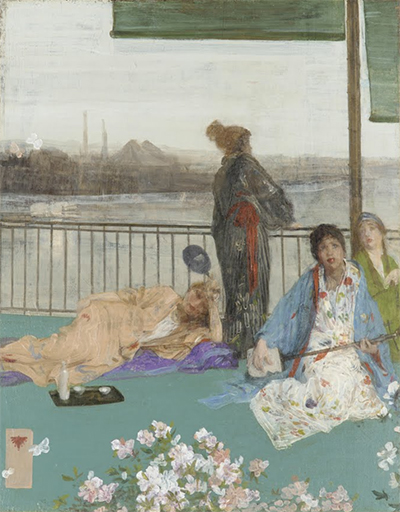Variations in Flesh Colour and Green - The Balcony is a painting, commenced in 1864 and finally completed in 1879, by the American artist, James Abbott McNeill Whistler, 1834-1903, in Victorian London, England, the country in which he was primarily based for the rest of his life after arriving there when he was twenty-five years old.
This intriguing artwork now resides in the Smithsonian Freer Gallery of Art, a gift from Charles Lang Freer (Whistler's most important collector), in Washington DC, USA. The size is h.61 x w.49cm. and its medium is oil paints on wood panel. Whistler often based his works' titles only on the most predominant colours depicted therein. His fundamental attitude to painting was that it was a basic process of reducing composition to its most formal elements, i.e. the variations of hues (see the very unusually named "Arrangement in Grey and Black, No. 1" of 1871). This was the first of his paintings to feature a butterfly (a stylisation of his initials and the symbol of metamorphosis) in a Japanese cartouche, which replaced his traditional signature.
Indeed, Whistler was one of the first serious Western admirers of Japanese art (please also see "Caprice in Purple and Gold - The Golden Screen" of 1864 and the "Nocturnes" of the 1870s). "Variations in Flesh Colour and Green" transforms an everyday view of his balcony, overlooking the River Thames, and his English models into a fantastical Japanese scene with national motifs: cherry blossoms, a stringed musical instrument, a hand fan, drapes, a sake bottle and tiny cups on a black lacquered tray and a floor mattress. The young Japanese ladies are adorned in oriental costumes, one of which has a particularly ornate design.
The bearings of the protagonists are plucked directly from the prints of the almost contemporary Utagawa Kunisada, Katsushika Hokusai and Utagawa Hiroshige, Japanese artists whose works were the first to reach the West. The very real, polluted and misty, industrial neighbourhood of Battersea provides the sombre background in stark contrast to the bright and imaginative foreground. The slag heaps' distinctive shapes are probably inspired by images of Mount Fuji. As is evident here, Whistler was a forerunner of the Japonism movement, a term coined in 1872 by the French art critic and collector, Philippe Burty, referring to all things Japanese in the art world.




